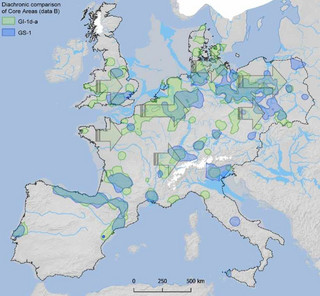A new study sheds light on how prehistoric hunter-gatherer populations in Europe coped with climate changes over 12,000 years ago. Led by scientists from the University of Cologne, a team of 25 prehistoric archaeologists from twenty European universities and research institutions revealed significant shifts in population size and density during key periods at the end of the last Ice Age, specifically during the Final Palaeolithic between 14,000 and 11,600 years ago. The study has been published in PLOS One under the title ‘Large scale and regional demographic responses to climatic changes in Europe during the Final Palaeolithic’.
The results reveal that the first establishment of a larger human population in north-eastern central Europe during the Final Palaeolithic was followed by a dramatic population decline during the last cold period (Greenland Stadial 1) of the Ice Age. This decline reduced the total population of Europe by half. However, the study found that some areas in central Europe show stability or even a slight increase in population size against the general trend. The team interprets this finding as evidence of human migration towards the east in response to worsening climate conditions.
By compiling a comprehensive database on archaeological sites from this period and using a cutting-edge geostatistical method called the Cologne Protocol, the researchers estimated population sizes and densities of prehistoric humans across different regions of Europe. The protocol provides a standardised procedure to estimate prehistoric demographic data, allowing for diachronic comparisons. The identified shifts in regional population sizes provide new insights into how early humans responded to the environmental challenges of their time.
The study focuses on two key periods: Greenland Interstadial 1d-a (GI-1d-a) and Greenland Stadial 1 (GS-1). During GI-1d-a, a warmer period of the Final Palaeolithic, humans continued to repopulate and expand into northern and north-eastern central Europe, making this region the centre of demographic dynamics in Europe for the first time in prehistory. Populations in south-western Europe, particularly in Spain and France, began to decline compared to population estimates for the preceding periods of the Upper Palaeolithic.
When the climate turned much colder during the subsequent GS-1, a climatic period known in the northern Hemisphere as the ‘Younger Dryas’, the total population of Europe decreases by half. But the new study shows that regional dynamics varied considerably: The estimates indicate an increase in population density in some areas of Europe (e.g. northern Italy, Poland and north-eastern Germany) as well as a general shift of populated areas from west to east. “These observations probably reflect the eastward movement of people in response to the very abrupt and pronounced climatic cooling during the Younger Dryas,” explains Dr Isabell Schmidt from the University of Cologne’s Department of Prehistoric Archaeology. “Humans during the Final Palaeolithic apparently responded by migrating to more favourable areas.”
The Cologne researchers are familiar with extreme population declines in Prehistory, such as during the late Gravettian (29,000 to 25,000 years ago), when cooler temperatures reduced populations in western and central Europe by up to two-thirds, leading to the extinction of regional populations.
Although demographic dynamics, particularly in these early phases of human prehistory, are still poorly understood, the new study adds to a growing body of evidence on how prehistoric humans responded to climate change, investigated at the University of Cologne in the framework of the Collaborative Research Centre 806 - Our Way to Europe, which was funded by the German Research Foundation (DFG) from 2009 to 2021. This work is currently being continued by the project HESCOR (Human and Earth System Coupling Research) at the University of Cologne, funded by the Ministry of Culture and Science of the State of North Rhine-Westphalia.
Media Contact:
Dr Isabell Schmidt
Department of Prehistoric Archaeology
+49 221 470 3385
isabell.schmidtuni-koeln.de
Press and Communications Team:
Eva Schissler
+49 221 470 4030
e.schisslerverw.uni-koeln.de
Publication:
https://journals.plos.org/plosone/article?id=10.1371/journal.pone.0310942
